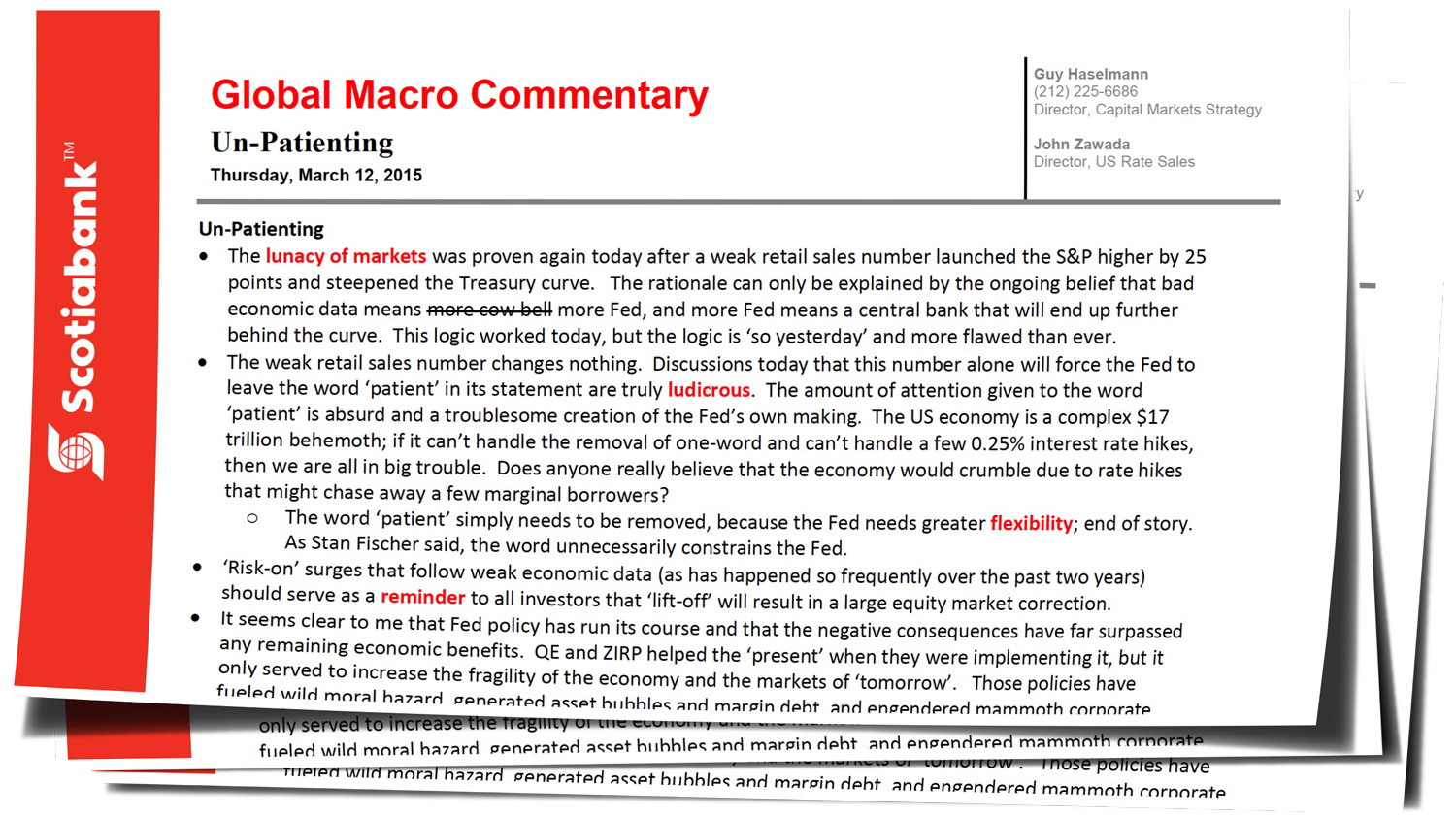Un-Patienting
by Guy Haselmann, Director, Capital Markets Strategy, Scotiabank GBM
· The lunacy of markets was proven again today after a weak retail sales number launched the S&P higher by 25 points and steepened the Treasury curve. The rationale can only be explained by the ongoing belief that bad economic data means more cow bell more Fed, and more Fed means a central bank that will end up further behind the curve. This logic worked today, but the logic is ‘so yesterday’ and more flawed than ever.
· The weak retail sales number changes nothing. Discussions today that this number alone will force the Fed to leave the word ‘patient’ in its statement are truly ludicrous. The amount of attention given to the word ‘patient’ is absurd and a troublesome creation of the Fed’s own making. The US economy is a complex $17 trillion behemoth; if it can’t handle the removal of one-word and can’t handle a few 0.25% interest rate hikes, then we are all in big trouble. Does anyone really believe that the economy would crumble due to rate hikes that might chase away a few marginal borrowers?
o The word ‘patient’ needs to be removed, simply because the Fed needs greater flexibility; end of story. As Stan Fischer said, the word unnecessarily constrains the Fed.
· ‘Risk-on’ surges that follow weak economic data (as has happened so frequently over the past two years) should serve as a reminder to all investors that ‘lift-off’ will result in a large equity market correction.
· It seems clear to me that Fed policy has run its course and that the negative consequences have far surpassed any remaining economic benefits. QE and ZIRP helped the ‘present’ when they were implementing it, but it only served to increase the fragility of the economy and the markets of ‘tomorrow’. Those policies have fueled wild moral hazard, generated asset bubbles and margin debt, and engendered mammoth corporate debt; conditions that continue to aggregate over time. The sooner the Fed hikes, the less-bad will be the systemic crisis of the future.
o It is the ‘risk-off’ financial market fallout, not the economic impact that the concerns the FOMC. The trouble is if the fallout is deep enough to impact economic conditions (a reverse wealth effect.)
· Removing the word ‘patient’ must preempt ‘lift-off’. The Fed is following the 2004 roadmap where it transitioned from ‘considerable period’ to using the word ‘patient’ twice. ‘Patient’ was then removed and at the subsequent meeting (March?) and then the word ‘gradual’ was used to define and warn of looming rate hikes (April?). This was followed by an actual hike at the ensuing meeting (June?). The template seems the same.
o Moreover, large maturities of SOMA securities in 2016 makes a June hike even more probable (see Scotia US Economist Dov Zigler’s March 6th note “When the Rubber Hits the Road for the Fed”).
· Many investors are anticipating a sharp bond rout when the Fed hikes rates. I could not disagree more. A hike is more likely to cause a major equity market drop. A hike would unwind significant amounts of ‘Fed-put’ type of speculation; the type that fueled today’s move. Moreover, it could further expose some of the global fragilities tied to a strong dollar, or a Chinese slowdown, or the years of extreme accommodation.
· When the Fed hikes, I expect flows out of risk assets into Treasuries. In a world where growth and inflation have been elusive, despite 6 years of ZIRP and over $10 trillion in global money printing, a hike could easily lead to a drop in growth and inflation expectations; thus, providing a further bid to long dated bonds.
· Regardless, bonds are not and have not been driven by fundamentals. There is an asymmetric distribution for Treasuries that is poorly understood by the market. While lower growth and inflation expectations will help bond prices, in the short run, the opposite will not hurt them. This condition exists because there is an enormous shortage of duration due to bank regulations and central bank hoarding.
· The ECB is now buying twice the amount of the net issuance of the Eurozone, magnifying the effect. Investors should stop thinking about Treasuries from a value perspective and realize they are a commodity in short supply. Yield curves in the US and Europe should flatten materially (well ahead of the forwards).
· The situation outlined above means that investors should not underestimate just how low yields can fall. It is not hard to make a case for back end yields dropping to all-time lows. I stand by the comment that I made a few months ago, where I said that the long bond would trade below 2% (a 1% handle) in 2015.
“I sell the things you need to be / I’m the smiling face on your TV / I’m the cult of personality / I exploit you, still you love me / I tell you one and one makes three / I’m the cult of personality” –Living Colour
Regards,
Guy
Guy Haselmann | Director, Capital Markets Strategy
▬▬▬▬▬▬▬▬▬▬▬▬▬▬▬▬▬▬▬▬▬▬▬▬▬▬▬
Scotiabank | Global Banking and Markets
250 Vesey Street | New York, NY 10281
T-212.225.6686 | C-917-325-5816
guy.haselmann[at]scotiabank.com
Scotiabank is a business name used by The Bank of Nova Scotia
Read/Download the complete report below or here:
Global Macro Commentary March 12(1)
Copyright © Scotiabank GBM















